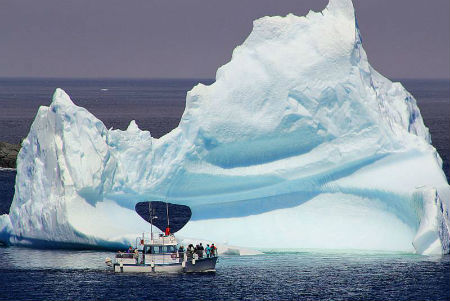Icebergs ‘on par’ this season in NL
Operators say iceberg traffic steady for tourists across Newfoundland
(Ed. – I didn't get home to Newfoundland this summer but this article really helped to cool me off in the Memphis heat.)
By David MacDonald
The Compass | August 14, 2019
 Icebergs are a big draw for tourists in Newfoundland. SUBMITTED PHOTO - Contributed
Icebergs are a big draw for tourists in Newfoundland. SUBMITTED PHOTO - ContributedWhile it wasn’t the highest number ever recorded, there are enough icebergs off the coast of Newfoundland and Labrador in 2019 to make visitors, and tourism operators alike, happy.
Derm Hickey, owner of Bonavista Puffin and Whale Tours in Bonavista, said while the weather wasn't cooperative early in the summer tourist season, at least 20 icebergs had been spotted in the area in early July thanks to favourable wind direction.
“Last year, there were only two for the whole season because the winds were off-shore, southerly and westerly winds, and it pushed them out (to sea),” he said. “This year, there were north and northeast winds, so icebergs were coming to shore.”
At the time Hickey was interviewed, he said there was only one iceberg left, but it was still a draw.
“It takes an hour to travel to that iceberg. (We’ve had) large groups of people, and a full group again today just for that one little iceberg.”
In St. Anthony, near the top of the Great Northern Peninsula, Paul Alcock, of Northland Discovery Tours, called it an average year.
At the time of this interview, Alcock said there were still “six or seven” icebergs in the area.
“Some smaller ones, medium and large of various shapes,” he said. “It’s pretty much on par.”
The manager of the St. Anthony Jungle Jim’s location, Sarah Richards, said tourism numbers remained steady this year.
In Twillingate, Barb Martin, a waitress for R & J Restaurant, also said tourist numbers appear to be steady.
“There wasn’t as many (icebergs) last year,” she said. “I know there have been customers (at the restaurant) who say they’ve seen icebergs.”
Deborah Bourden, co-owner of Anchor Inn Hotel in Twillingate, said her numbers suggest this year is “right on par” with last year. She said icebergs are always a major draw, even during the poor weather earlier in the season. Even in early July, there were reports of a good-sized iceberg 25 minutes from shore.
“You only need to have one good iceberg to get people out,” Bourden said.
Tourism lifeline
Bourden said tourism is the lifeline of rural Newfoundland, and everyone’s hard work always pays off year after year.
Over the years, tour operators have looked for new and innovative ways to keep customers coming.
In Alcock’s case, the most recent addition to his operation is a Zodiac Adventure tour that provides a more one-on-one experience for customers who want to spend more time on their own individual interests, whether it’s icebergs, whales or puffins.
“It gives us the option to do what the customer wants,” he said.
While icebergs remain a common sight off the coast of Newfoundland, the fact is that climate change is a major concern worldwide, including here in the Atlantic region, putting the polar ice cap at risk.
Hickey said he considers that to be a question for the scientists to answer, but he says it would be devastating to his business if climate change resulted in fewer icebergs being sighted.
“If we lost the icebergs … it would cut our business in half,” he said.
All about icebergs
- Icebergs are large chunks of ice that have broken off a glacier, ice shelf or even another, larger iceberg and float in open water via ocean currents.
- Icebergs come in different sizes and shapes; typically, they are only referred to as an iceberg if they measure more than five metres across.
- Only a small portion portion of the total mass of the iceberg is typically visible above the surface of the water. About 90 per cent is below sea level.
- Smaller icebergs – called “growlers” – are particularly dangerous for ships because they are difficult to spot.
- After the Titanic sunk off Newfoundland in 1912, the International Ice Patrol was formed to warn ships of icebergs. Airplanes and radars are used to track icebergs that are more than 500 square metres that drift into shipping lanes.
- The North Atlantic and Antarctica are home to most of Earth’s icebergs.
- When icebergs reach warmer waters, the warmer air melts snow and ice into pools called melt ponds, which trickle through the iceberg and widen existing cracks. The warmer waters melt the iceberg from the bottom up, often causing chunks of ice to break off.
Source: National Snow and Ice Data Centre, nsidc.org